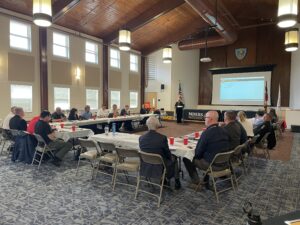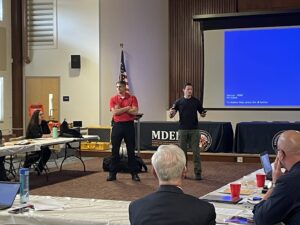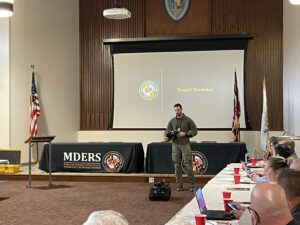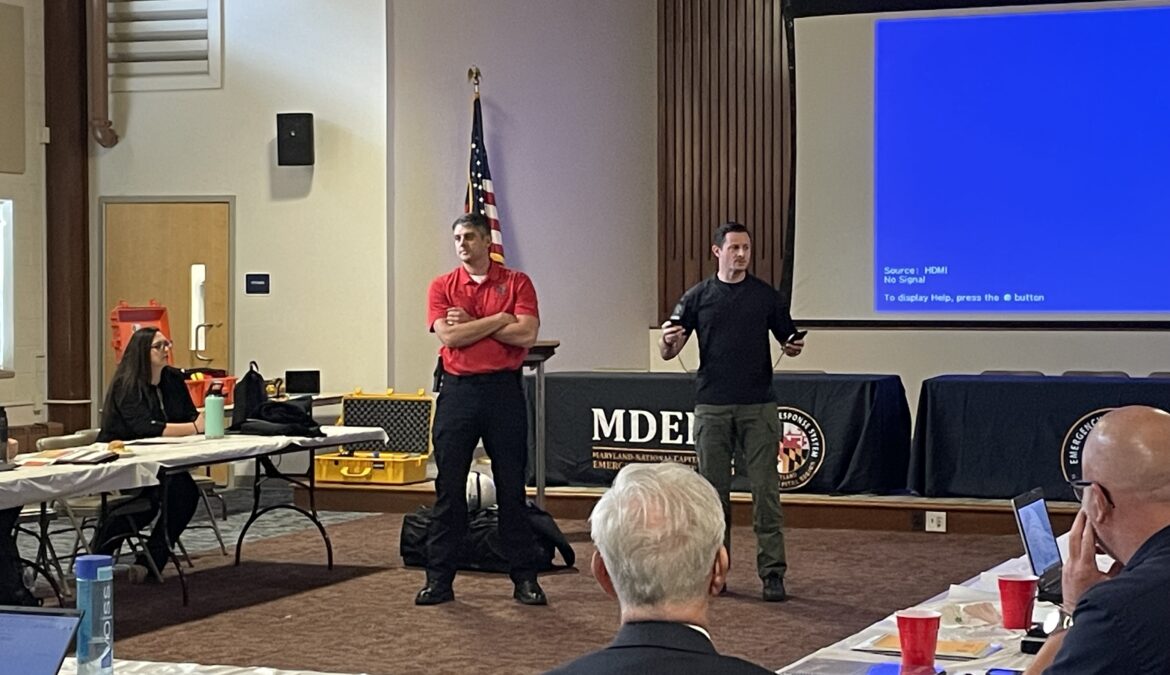The Maryland-National Capital Region Emergency Response System (MDERS) conducted an in-person Steering Committee meeting to allow stakeholders and staff to reconvene after engaging in numerous virtual forums due to the restrictions of the COVID-19 pandemic. In this opportunity, MDERS Steering Committee stakeholders elected new chair officers, reviewed innovation fund proposals, and showcased current response capabilities to attendees.
The MDERS Steering Committee serves as a platform for multidisciplinary stakeholders to share ideas, discuss pertinent topics, and provide recommendations on diverse proposals, with the aim of garnering consensus, raising awareness, and securing approval for distinctive public safety capabilities that enhance emergency response operations. Comprised of inter-jurisdictional leadership from fire/rescue/EMS, law enforcement, emergency management, public health, hospital, and regional/state agencies, these partnerships ensure the enhancement of interoperability in Montgomery and Prince George’s Counties.

Over the past several years, the MDERS Steering Committee has been guided by Chair, Major Charles Magee of Prince George’s County Police Department (PGPD) and Vice Chair, Assistant Chief Tracy McDonald of Montgomery County Fire Rescue Service (MCFRS), who provided invaluable structure and profound influence during their four-year tenure in these roles.
MDERS and its partners express sincere gratitude to both individuals for their steadfast dedication in navigating unprecedented times marked by the COVID-19 pandemic, financial adjustments, and abnormal work conditions. With the conclusion of their terms, members of the Steering Committee had the opportunity to elect new officers to fulfill the Chair and Vice Chair roles. MDERS congratulates newly appointed Chair MCFRS Assistant Chief Tracy McDonald and Vice Chair PGPD Sergeant Nicholas Fiore on their election.

Following the conclusion of the election, principal stakeholder agencies provided comprehensive presentations showcasing their recently integrated response capabilities. The presentations aimed to highlight specific functions and procedures that contribute to enhancing public safety operations. Each agency demonstrated how these sophisticated tools, designed for managing incidents of varying scales, play a crucial role in preserving lives, reinforcing coordinated responses, elevating training standards, and enhancing productivity during emergencies. The following is a list of the capabilities presented.
Prince George’s County Office of Homeland Security and Emergency Management (OHS/EM)
- Community Lifeline Application enables users to obtain real-time incident information on assets, services, and capabilities essential to community needs. The lifeline application created by PG OHS/EM to support Continuity of Operations Planning (COOP) gives users access to pertinent topics affecting human health, including safety/security, communication, food/shelter, water systems, energy, and hazardous materials.
Prince George’s County Police Department (PGPD)
- EST Medic LIFEPAK equips tactical medics with the capacity to identify, evaluate, and treat cardiac emergencies. Medics can use the defibrillator to treat unstable cardiac patients and monitor alterations to their vital signs.
- First Line Supervisors Command Book provides first-line supervisors with the tools and resources to effectively respond to diverse incidents. This guide contains a series of job aids, checklists, and worksheets for high-impact events, including barricaded suspects, bomb threats, active shooters, kidnappings, civil demonstrations, wounded officers, and rescue task force.
- Public Order Equipment contains full-body protective gear, helmets, and ballistic shields that increase officer safety at the forefront of active violence, mass gatherings, and hazardous materials. When deployed, public order teams wear full body armor covering their legs, arms, torso, and facial area.
Montgomery County Department of Health and Human Services (MCDHHS)
- Medical Resource Officer (MRO) Program provides logistical, medical, and other critical functions to support response efforts to public health crises. The MRO oversees the Medical Reserve Corp (MRC) administration and coordination to reinforce response efforts to public health events.

Montgomery County Fire Rescue Services (MCFRS)
- PerSim software can simulate various medical emergencies to enhance training opportunities for first responders. Participants wear a headset that produces a 3-D holographic patient overlaid on a training manikin. Participants can initiate and perform medical procedures through the simulated emergency, prompting them to assess the situation and apply life-saving techniques imperative for resolving real-world incidents.
Montgomery County Fire and Rescue Service (MCFRS) and Prince George’s County Fire Department (PGFD)
- Leader Search Bluetooth Listening sensor allows structural collapse teams to listen for trapped victims and detect those in confined spaces to enhance search and rescue efforts during a structural collapse incident.
- Paratech Rescue Guardian system monitors structural changes to a collapsed building and gathers on-scene intelligence to alert fire personnel of sudden shifts. The system provides instantaneous notification upon sensing building alterations to allow fire personnel to exit the compromised structure before a potential secondary collapse and reevaluate the scene to adjust the device accordingly.

Montgomery County Police Department (MCPD)
- ICOR Robots contribute to reducing potential threats to officer safety due to the ability to operate from a safe distance and reach vulnerable positions that do not expose officers to hazardous conditions. These robots contain cameras and audio systems that capture on-scene intelligence for decision-making while allowing law enforcement personnel to communicate with individuals.
Holy Cross Hospital
- Healthcare Capabilities revolve around response and preparedness necessary to support personnel in providing optimal patient care. Hospital systems improved emergency response to active threat events by obtaining a transport truck to mobilize mass casualty incident supplies. The super duty box truck ensures medical cache movement and replenishment of critical supplies to healthcare facilities experiencing an acute surge. In addition, hospitals have enhanced their preparedness for mass casualty incidents associated with hazardous materials through procuring Zumro decontamination shelter systems. These efforts have been imperative to recover quickly from all-hazard events and maintain the quality of medical treatment operations.
Members of the Steering Committee uphold distinctive public safety initiatives that reinforce their overall response procedures, plans, and policies to achieve departmental objectives. MDERS will continue to serve as the single point of collaboration between all disciplines involved in emergency response to integrate capabilities to provide superior service to residents in Montgomery and Prince George’s Counties.


